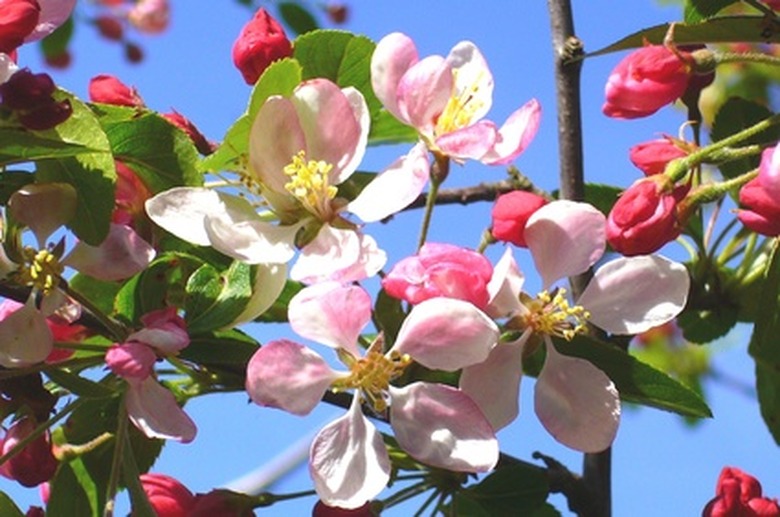Flowering Trees In Texas
The plains, deserts and coastal areas of Texas are home to a variety of flowering trees. The attractive silhouettes and showy blooms of these flowering trees can add interest to the home landscape. Native trees provide the added benefit of requiring little attention from gardeners because they are suited to the climate and conditions of the area.
Southern Crabapple
Southern crabapple, or Malus angustifolia, grows between 25 and 30 feet tall, forming thickets with its dense, spreading branches. In spring, fragrant pink flowers open from red buds. The flowers fade to white over time and are followed by yellowish green fruit. Southern crabapple tolerates a variety of soil conditions but performs best in deep, rich, well-drained soil. Provide southern crabapple with significant space to avoid outbreaks of disease and plant in full sun. Prune in winter to remove suckers and shape the tree.
- The plains, deserts and coastal areas of Texas are home to a variety of flowering trees.
- Native trees provide the added benefit of requiring little attention from gardeners because they are suited to the climate and conditions of the area.
Texas Mountain Laurel
The small evergreen tree known as Texas mountain laurel, or Sophora secundiflora, grows to 25 feet tall. The upright branches and multiple trunks bear dark green, glossy leaves consisting of smaller leaflets. Clusters of drooping blue or violet flowers bloom from midwinter through early spring. Bright red poisonous seeds appear from inside open gray seedpods in the summer. Texas mountain laurel enjoys the summer heat of Texas. Plant in full sun and well-drained, alkaline soil for best results.
Desert Willow
Chilopsis linearis, commonly called desert willow, features shaggy bark and twisted trunks that reach up to 30 feet tall and spread to 20 feet wide. From spring through fall, trumpet-shaped flowers of reddish purple, pink or white bloom among the willow-like foliage. Native to desert washes and low elevation stream beds in the southwestern United States, desert willow prefers dry conditions and full sun.
- The small evergreen tree known as Texas mountain laurel, or Sophora secundiflora, grows to 25 feet tall.
- From spring through fall, trumpet-shaped flowers of reddish purple, pink or white bloom among the willow-like foliage.
Wild Olive
Clusters of white flowers with yellow centers bloom from the branches of wild olive in spring. Also known as Cordia boissieri, this small tree reaches up to 10 feet tall. The grayish green, oval-shaped leaves grow to 3 inches long. Wild olive does not tolerate cold weather and performs best in southern Texas. Plant in full sun and provide young trees with regular water. Once established, wild olive tolerates dry conditions.
Jerusalem Thorn
The yellowish green bark and thorny twigs of Jerusalem thorn, or Parkinsonia aculeata, form an attractive silhouette that reaches up to 30 feet high. The slightly arching branches hold stems of leaves divided into small leaflets. Long, loose clusters of yellow flowers bloom in the spring and periodically throughout the year. Seed pods that grow between 2 and 6 inches long appear in summer, after the flowers have faded. Jerusalem thorn grows well in full sun and in both dry and moist conditions, as long as the soil drains well.
- Clusters of white flowers with yellow centers bloom from the branches of wild olive in spring.
- The yellowish green bark and thorny twigs of Jerusalem thorn, or Parkinsonia aculeata, form an attractive silhouette that reaches up to 30 feet high.
References
- Texas AgriLife Extension: Some Trees Recommended for Texas
- "The Southern Living Garden Book"; Steve Bender; 2004
